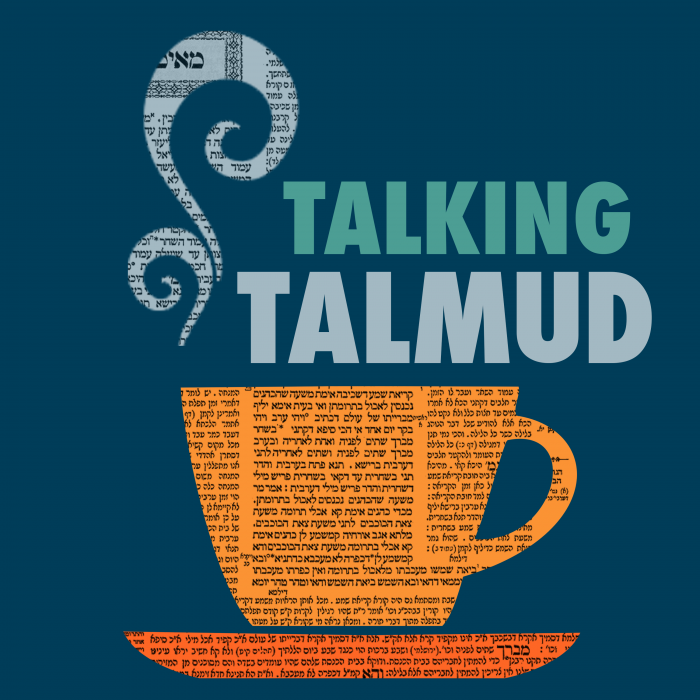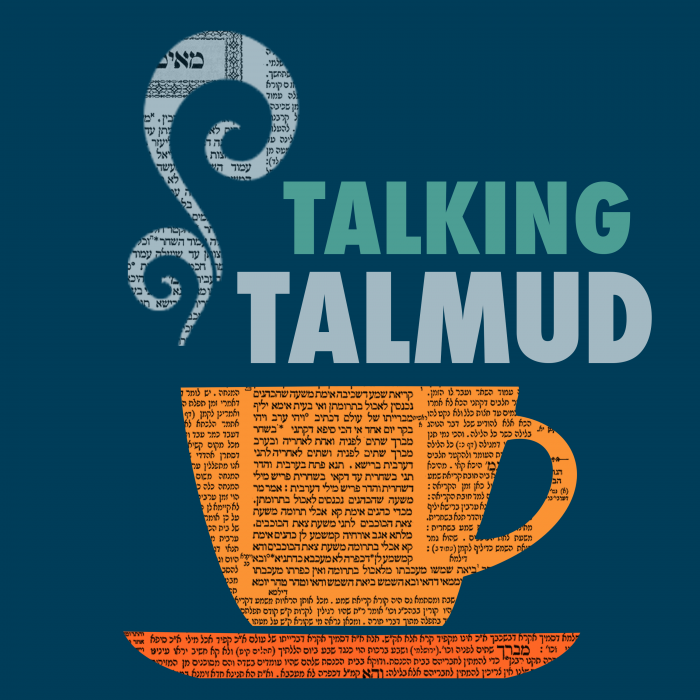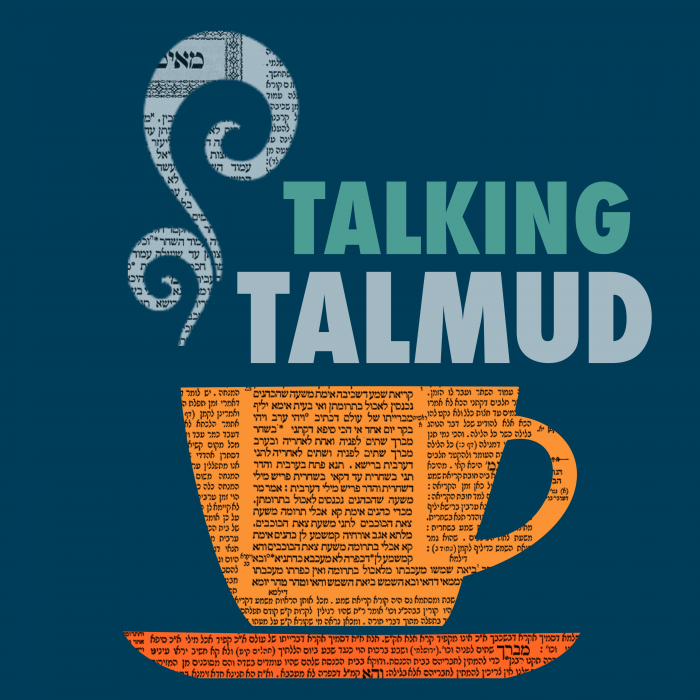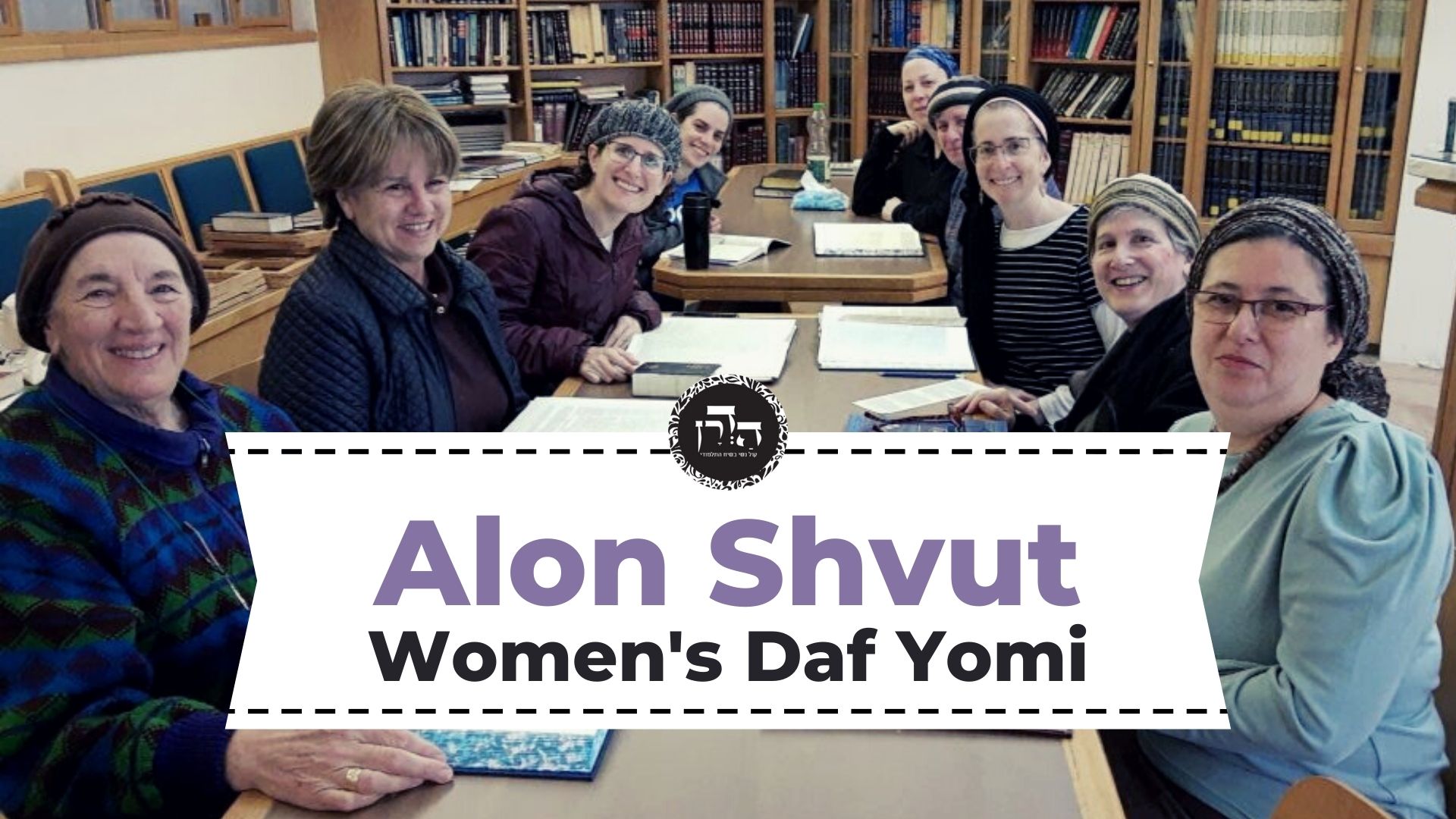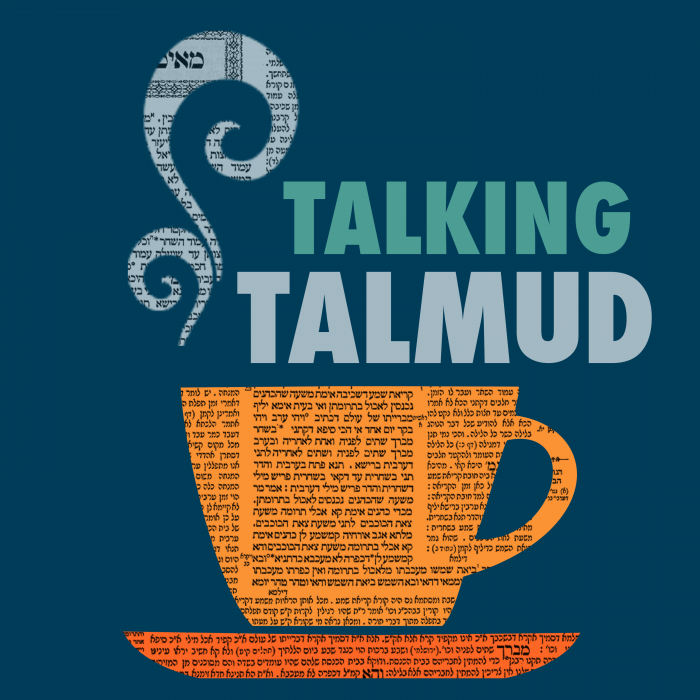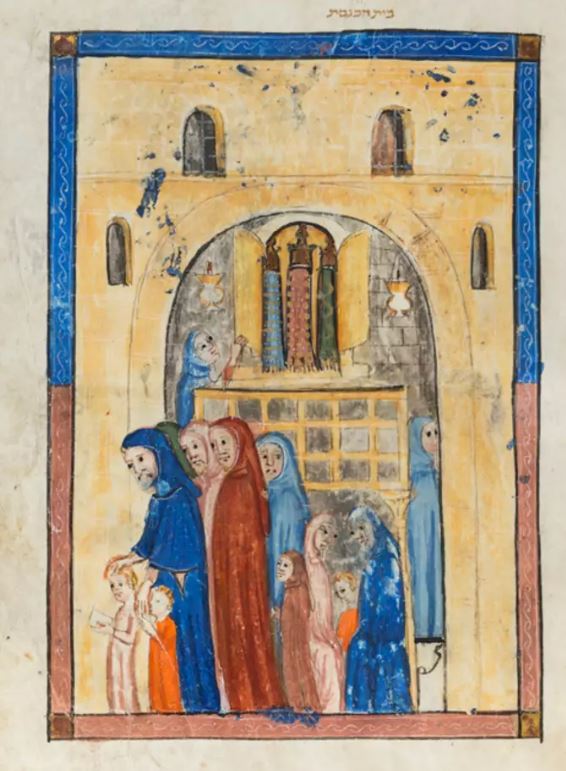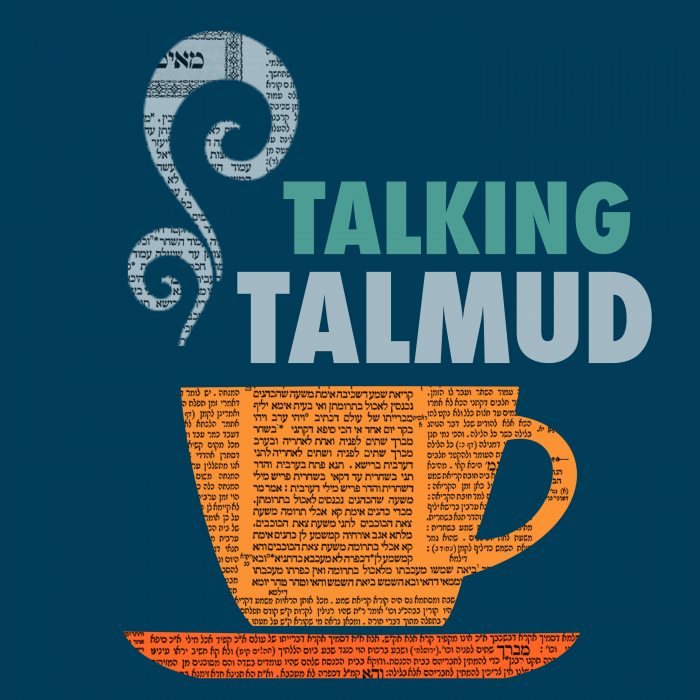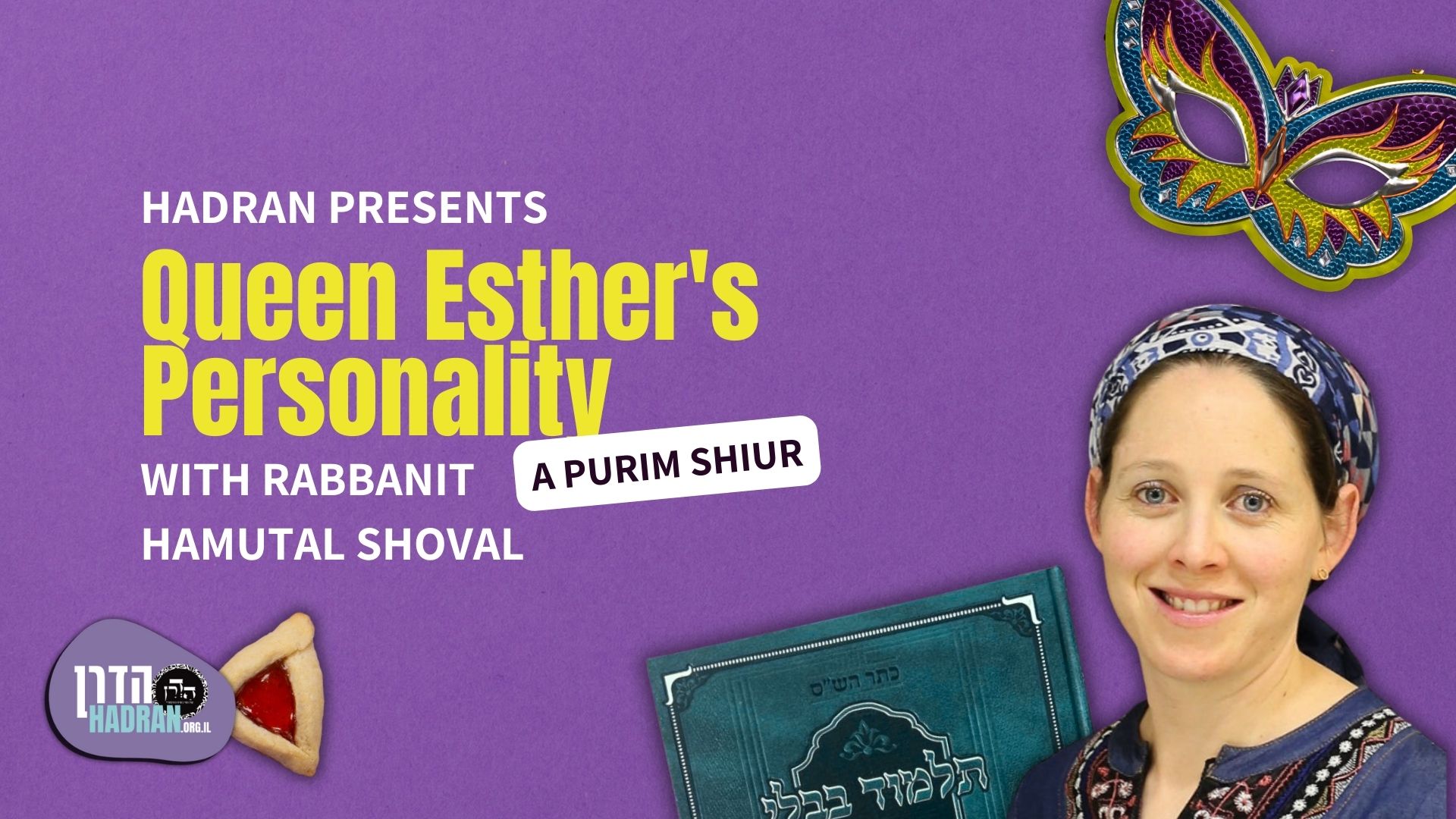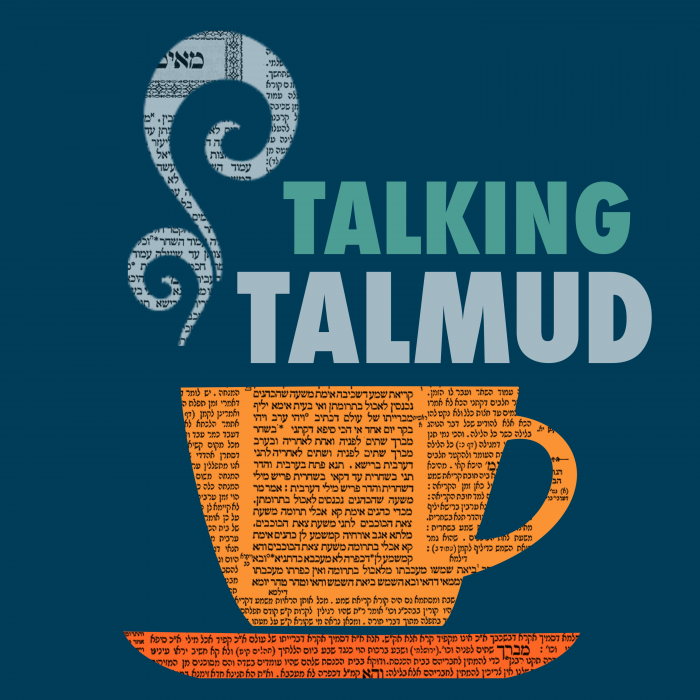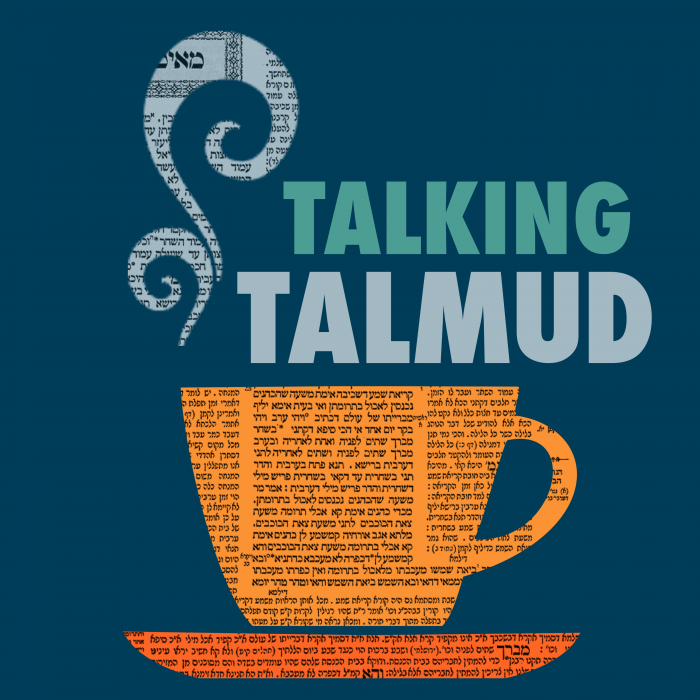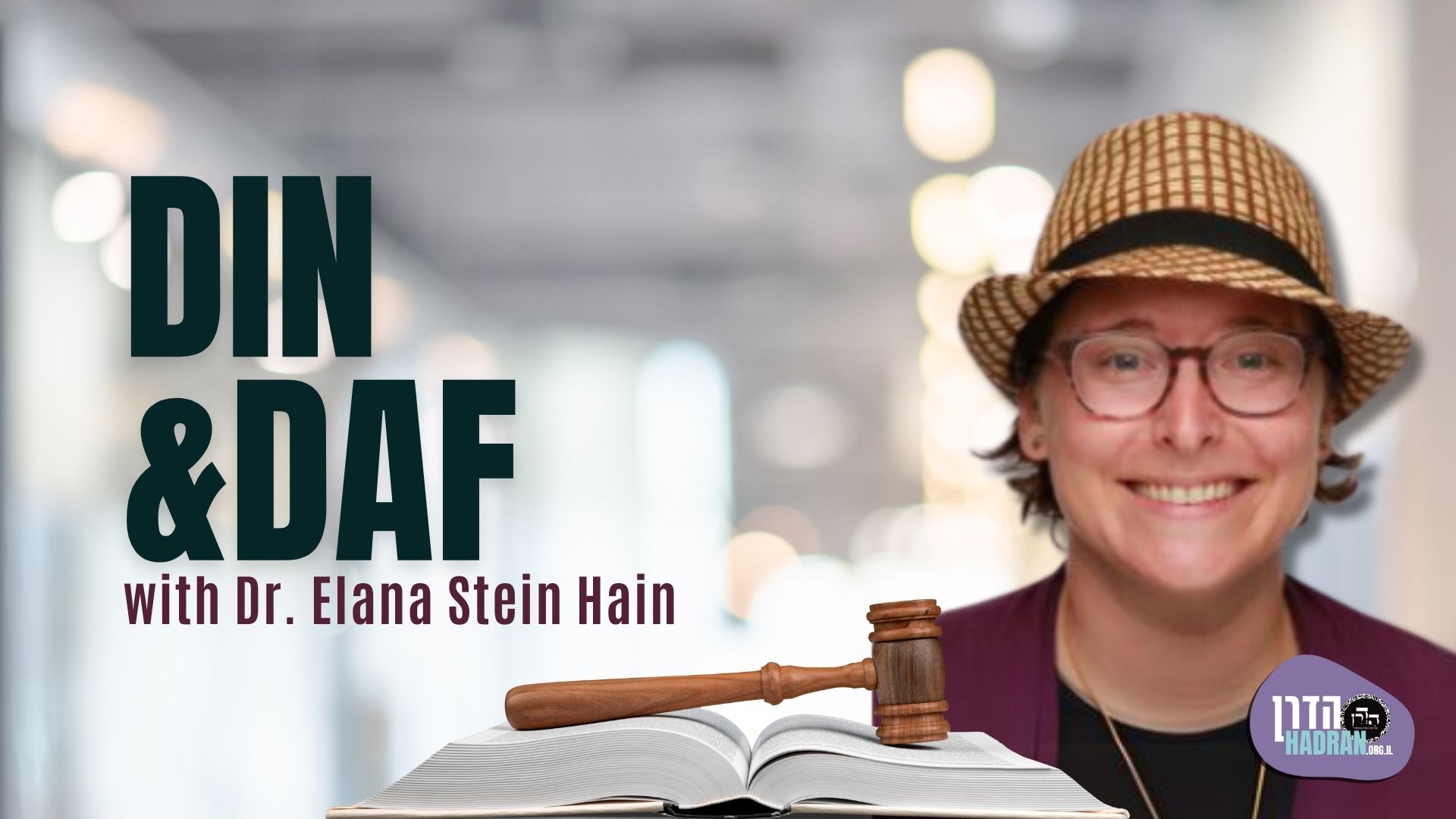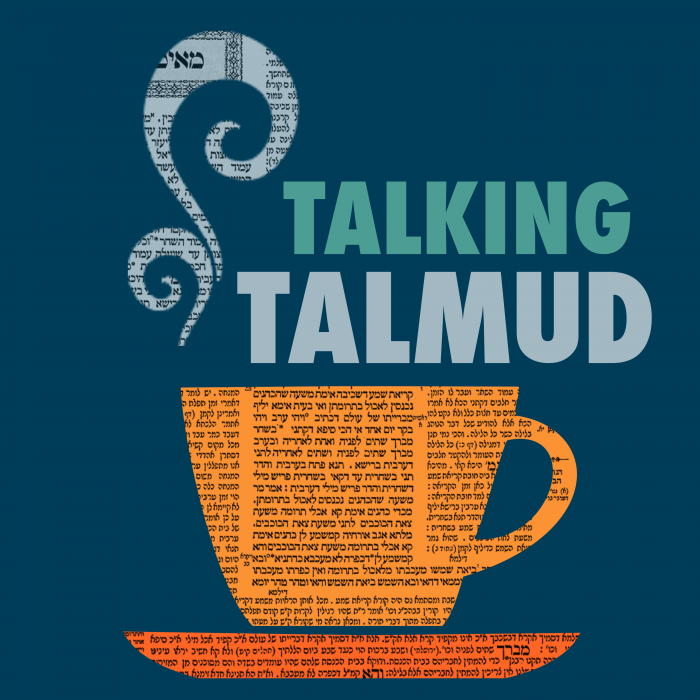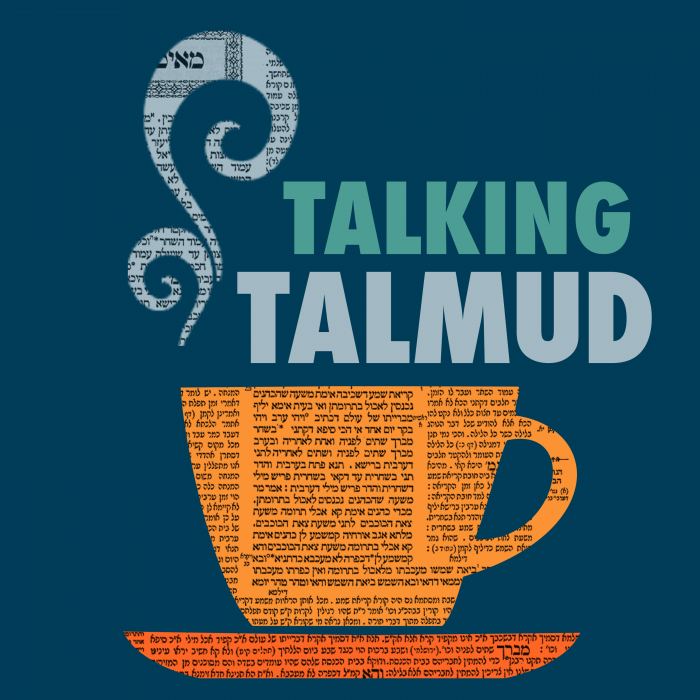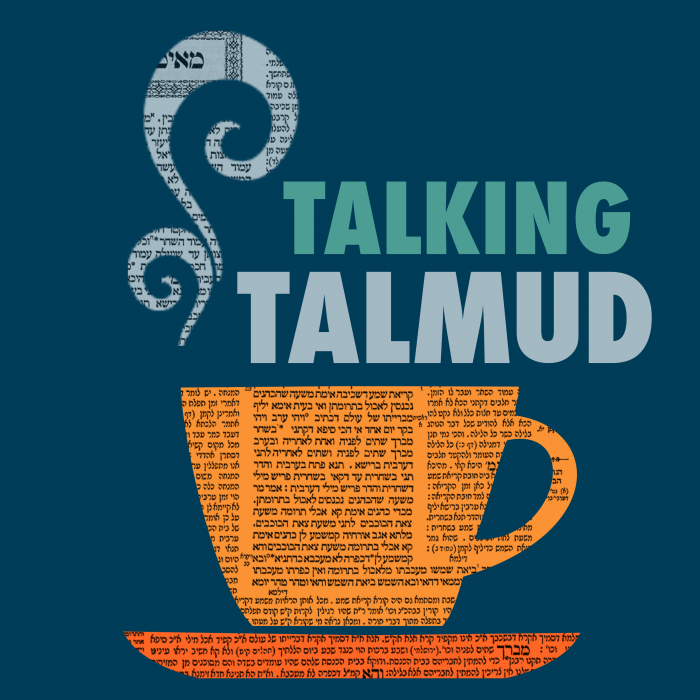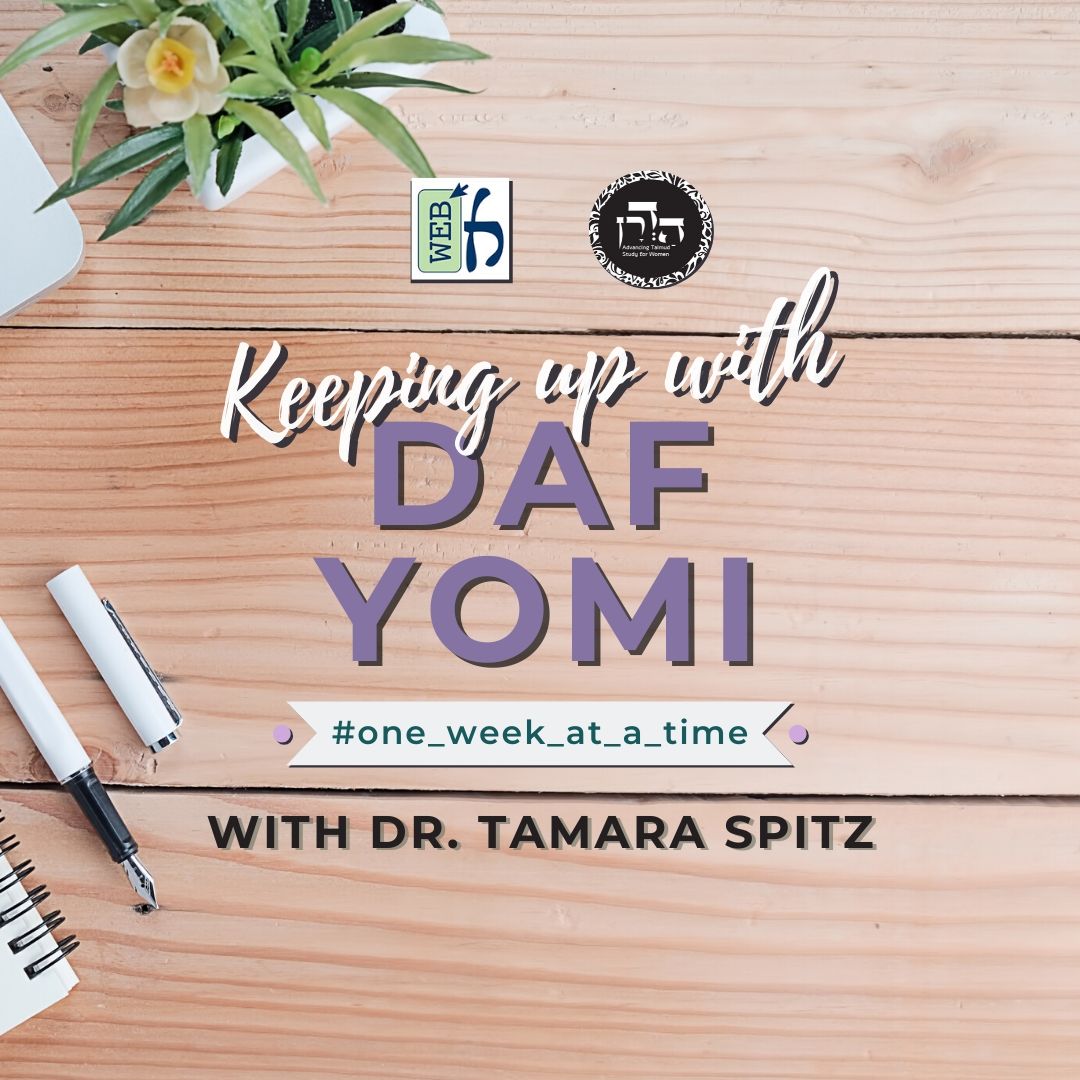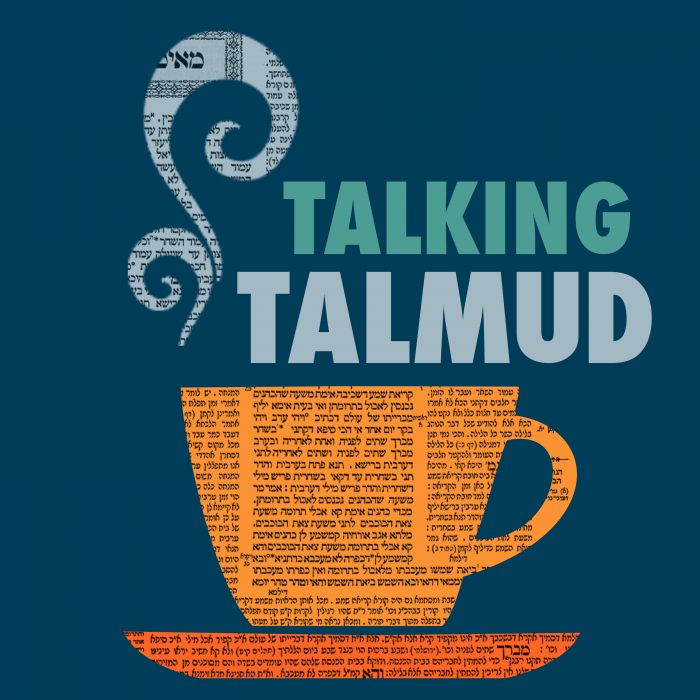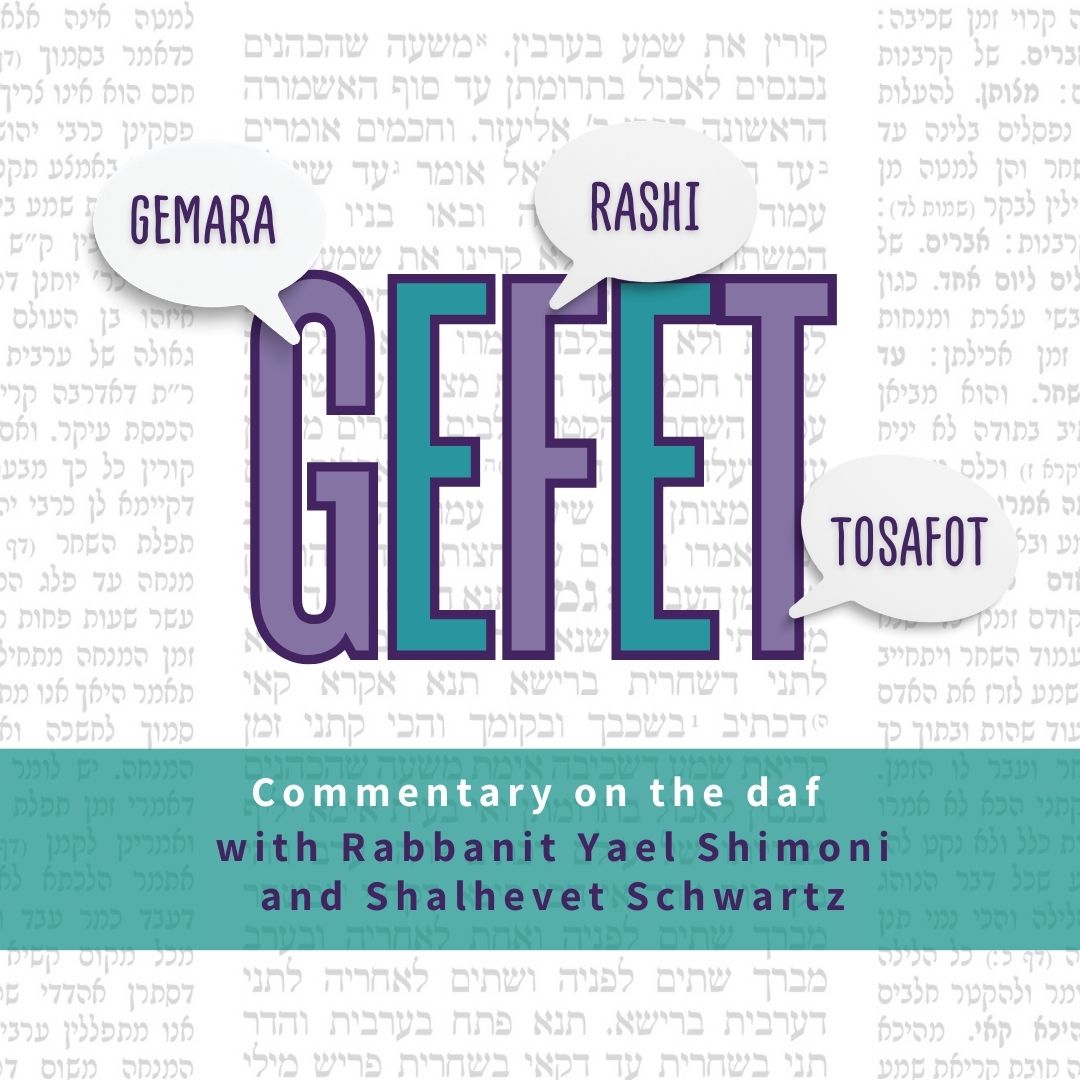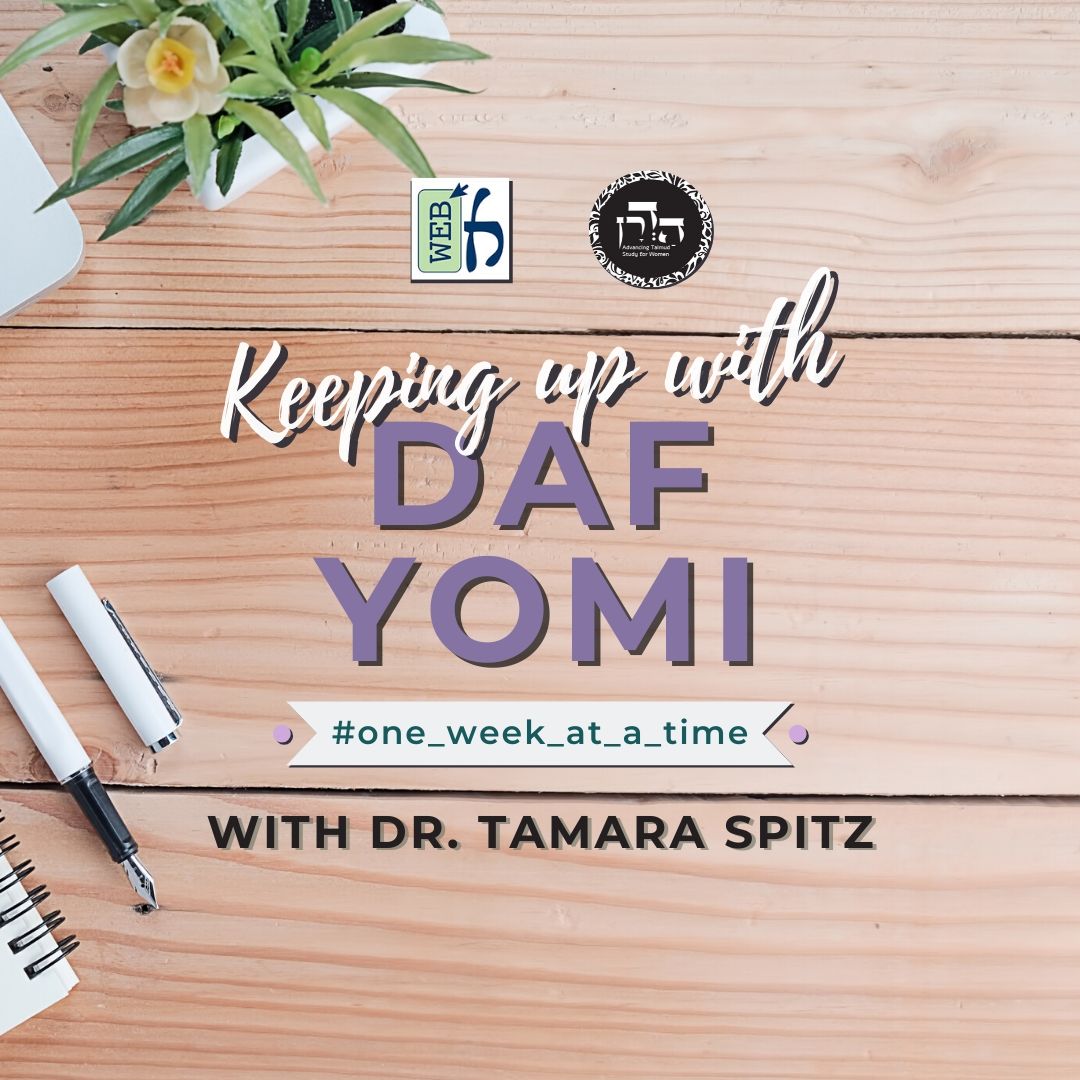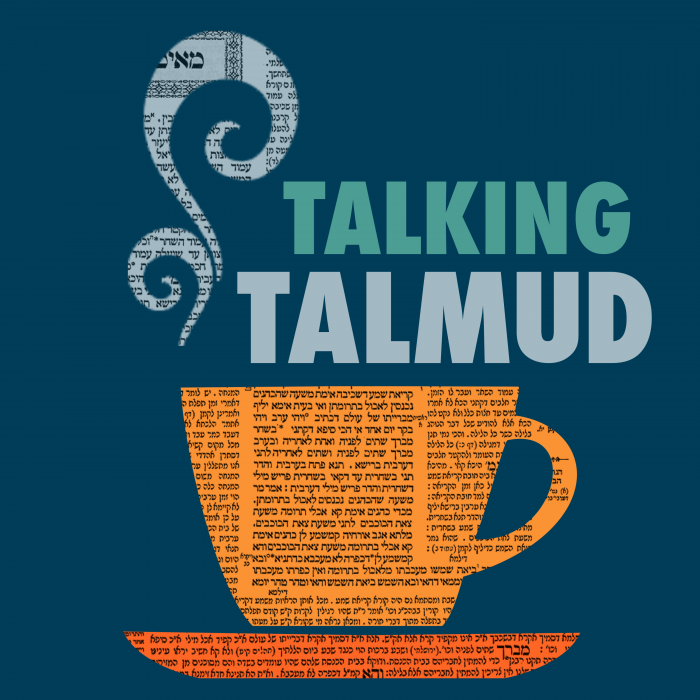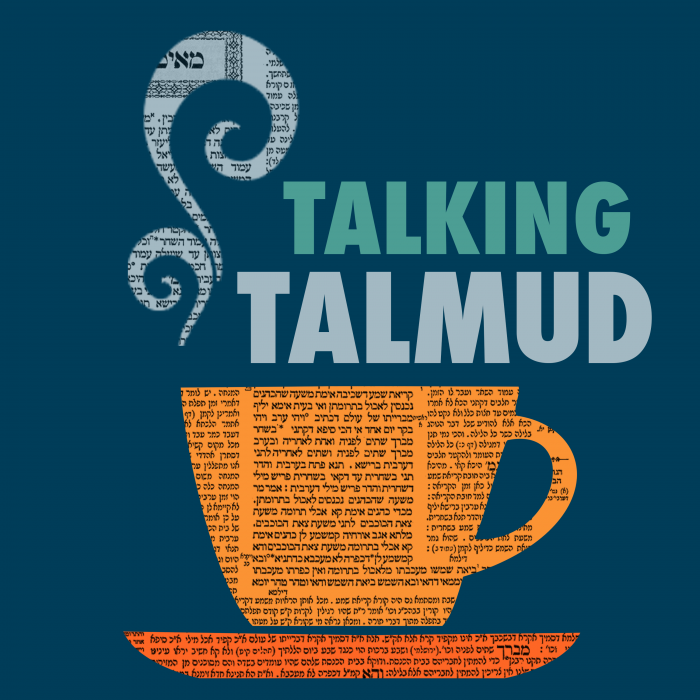3 arguments are brought between Rabbi Yochanan and Reish Lakish regarding issues that mayarisee during the process of preparing and the burning of the kmitza from the meal offering.
This week’s learning is sponsored by Robert and Paula Cohen in loving memory of Joseph Cohen, Yosef ben Moshe HaCohen, z”l. “He was hard working, loved to sing, esp. as a chazan, and was very dedicated to his family and community.”
Want to dedicate learning? Get started here:

Today’s daily daf tools:
This week’s learning is sponsored by Robert and Paula Cohen in loving memory of Joseph Cohen, Yosef ben Moshe HaCohen, z”l. “He was hard working, loved to sing, esp. as a chazan, and was very dedicated to his family and community.”
Today’s daily daf tools:
Delve Deeper
Broaden your understanding of the topics on this daf with classes and podcasts from top women Talmud scholars.
New to Talmud?
Check out our resources designed to help you navigate a page of Talmud – and study at the pace, level and style that fits you.
The Hadran Women’s Tapestry
Meet the diverse women learning Gemara at Hadran and hear their stories.
Menachot 9
״בְּקֹדֶשׁ הַקֳּדָשִׁים תֹּאכְלֶנּוּ״.
“Every meal offering of theirs, and every sin offering of theirs, and every guilt offering of theirs, which they may render unto Me, shall be most holy for you and for your sons. In the Sanctuary you shall eat them” (Numbers 18:9–10). This indicates that although the mitzva is to consume offerings of the most sacred order in the courtyard, in certain instances the priests may consume these offerings inside the Sanctuary, the most holy place.
וְהָא לְמָה לִי קְרָא? לֵימָא: ״בַּחֲצַר אֹהֶל מוֹעֵד יֹאכְלוּהָ״, וְלֹא יְהֵא טָפֵל חָמוּר מִן הָעִיקָּר.
The Gemara explains its objection: But according to the opinion of Rabbi Yoḥanan, why do I need this verse? Let him say here as well that as the verse states: “In the court of the Tent of Meeting they shall eat it” (Leviticus 6:9), i.e., in the Temple courtyard, it is logical that the halakha with regard to the minor area should not be more stringent than the halakha with regard to the major one, i.e., if one may consume a peace offering in the Temple courtyard then all the more so may he consume it in the Sanctuary.
עֲבוֹדָה, דְּאָדָם עוֹבֵד בִּמְקוֹם רַבּוֹ, אָמְרִינַן שֶׁלֹּא יְהֵא טָפֵל חָמוּר מִן הָעִיקָּר. אֲכִילָה, שֶׁאֵין אָדָם אוֹכֵל בִּמְקוֹם רַבּוֹ, טַעְמָא דִּכְתַב קְרָא, הָא לָא כְּתַב קְרָא – לֹא יְהֵא טָפֵל חָמוּר מִן הָעִיקָּר לָא אָמְרִינַן.
The Gemara explains: Consuming an offering is not the same as slaughtering it. The slaughter of an offering is part of the sacrificial service, and it is not considered disrespectful for a person to serve his master in the place of his master, i.e., within the Sanctuary as well as in the courtyard. Therefore, we say that the halakha with regard to the minor area should not be more stringent than the halakha with regard to the major one. By contrast, with regard to the consumption of an offering, since a person may not eat in the place of his master, the only reason that it is permitted to consume an offering inside the Sanctuary is that it is written in the verse: “In a most holy place you shall eat them.” Had this not been written in the verse explicitly, we would not say that the halakha with regard to the minor area should not be more stringent than the halakha with regard to the major one.
אִיתְּמַר: בְּלָלָהּ חוּץ לְחוֹמַת עֲזָרָה, רַבִּי יוֹחָנָן אָמַר: פְּסוּלָה, רֵישׁ לָקִישׁ אָמַר: כְּשֵׁרָה. רֵישׁ לָקִישׁ אָמַר כְּשֵׁרָה, דִּכְתִיב: ״וְיָצַק עָלֶיהָ שֶׁמֶן וְנָתַן עָלֶיהָ לְבוֹנָה״, וַהֲדַר ״וֶהֱבִיאָהּ אֶל בְּנֵי אַהֲרֹן הַכֹּהֲנִים וְקָמַץ״.
§ It was stated: If one mixed the oil of a meal offering into it outside the wall of the Temple courtyard, Rabbi Yoḥanan says that it is disqualified, and Reish Lakish says that it is valid. Reish Lakish says: It is valid, as it is written: “And he shall pour oil upon it, and put frankincense upon it” (Leviticus 2:1), and then it is written: “And he shall bring it to Aaron’s sons the priests; and he shall remove” (Leviticus 2:2).
מִקְּמִיצָה וְאֵילָךְ מִצְוַת כְּהוּנָּה, לִימֵּד עַל יְצִיקָה וּבְלִילָה שֶׁכְּשֵׁרִין בְּזָר, וּמִדִּכְהוּנָּה לָא בָּעֲיָא, פְּנִים נָמֵי לָא בָּעֲיָא.
Reish Lakish explains: The Sages derived from here that from the removal of the handful onward the rites performed with the meal offering are solely a mitzva of the priesthood. Accordingly, the verse taught about pouring and mixing that they are valid when performed by a non-priest. And from the fact that the priesthood is not required for the mixing, it may be derived that it is also not required that its performance be inside the walls of the Temple courtyard.
וְרַבִּי יוֹחָנָן אָמַר: פְּסוּלָה, כֵּיוָן דַּעֲשִׂיָּיתָהּ בִּכְלִי הוּא, נְהִי דִּכְהוּנָּה לָא בָּעֲיָא, פְּנִים מִיהַת בָּעֲיָא. תַּנְיָא כְּוָותֵיהּ דְּרַבִּי יוֹחָנָן: בְּלָלָהּ זָר – כְּשֵׁרָה, חוּץ לְחוֹמַת הָעֲזָרָה – פְּסוּלָה.
And Rabbi Yoḥanan says: This meal offering is disqualified, since a meal offering’s performance is in a service vessel. Therefore, granted that the priesthood is not required, yet in any event its performance inside the Temple courtyard is required. The Gemara notes that it is taught in a baraita in accordance with the opinion of Rabbi Yoḥanan: If a meal offering was mixed by a non-priest it is valid. But if it was mixed outside the wall of the Temple courtyard it is disqualified.
אִיתְּמַר: מִנְחָה שֶׁחָסְרָה קוֹדֶם קְמִיצָה, רַבִּי יוֹחָנָן אָמַר: יָבִיא מִתּוֹךְ בֵּיתוֹ וִימַלְּאֶנָּה, רֵישׁ לָקִישׁ אָמַר: לָא יָבִיא מִתּוֹךְ בֵּיתוֹ וִימַלְּאֶנָּה.
§ It was stated: With regard to a meal offering that became lacking in its full measure before the removal of the handful, Rabbi Yoḥanan says that the owner shall bring additional flour from within his home and shall fill the missing part of the measure of the meal offering. Reish Lakish says: He shall not bring flour from within his home and fill it. Instead, he must bring a new meal offering.
רַבִּי יוֹחָנָן אָמַר: מֵבִיא מִתּוֹךְ בֵּיתוֹ וִימַלְּאֶנָּה, קְמִיצָה קָבְעָה לֵיהּ. רֵישׁ לָקִישׁ אָמַר: לָא יָבִיא מִתּוֹךְ בֵּיתוֹ וִימַלְּאֶנָּה, קְדוּשַּׁת כְּלִי קָבְעָה לֵיהּ.
The Gemara explains: Rabbi Yoḥanan says that he brings flour from within his home and he fills it, as the removal of the handful establishes it as a meal offering to the extent that it may become disqualified. Before the removal, one may always add flour to the meal offering. Reish Lakish says: He shall not bring flour from within his home and fill it, as the sanctity of the service vessel establishes it as a meal offering. Therefore, once the meal offering was placed in a service vessel and sanctified, it is disqualified if it becomes lacking.
אֵיתִיבֵיהּ רַבִּי יוֹחָנָן לְרַבִּי שִׁמְעוֹן בֶּן לָקִישׁ: חָסֵר הַלּוֹג, אִם עַד שֶׁלֹּא יָצַק – יְמַלְּאֶנּוּ, תְּיוּבְתָּא.
Rabbi Yoḥanan raised an objection to Rabbi Shimon ben Lakish, Reish Lakish, from a mishna (Nega’im 14:10) discussing the log of oil brought by a leper: In a case where the log lacked a full measure, if it became lacking before the priest poured from it into his palm in order to place it on the right thumb and big toe of the leper, he shall fill it. Clearly the service vessel containing the log does not sanctify the oil to the extent that it can become disqualified. The Gemara notes: Indeed, this is a conclusive refutation of the opinion of Reish Lakish.
אִיתְּמַר: שִׁירַיִם שֶׁחָסְרוּ בֵּין קְמִיצָה לְהַקְטָרָה, רַבִּי יוֹחָנָן אָמַר: מַקְטִיר קוֹמֶץ עֲלֵיהֶן, וְרֵישׁ לָקִישׁ אָמַר: אֵין מַקְטִיר קוֹמֶץ עֲלֵיהֶן. אַלִּיבָּא דְּרַבִּי אֱלִיעֶזֶר כּוּלֵּי עָלְמָא לָא פְּלִיגִי, כִּי פְּלִיגִי אַלִּיבָּא דְּרַבִּי יְהוֹשֻׁעַ.
§ It was stated: With regard to the remainder of a meal offering that became lacking between the removal of the handful and its burning upon the altar, Rabbi Yoḥanan says that one burns the handful on account of such a remainder, and that the remainder is then permitted for consumption. And Reish Lakish says that one does not burn the handful on account of the remainder. The Gemara notes: According to the opinion of Rabbi Eliezer, everyone agrees that the handful is burned on account of the remainder. In other words, both amora’im, Rabbi Yoḥanan and Reish Lakish, concur that this is the halakha according to the tanna Rabbi Eliezer. When they disagree, it is concerning the halakha according to the opinion of Rabbi Yehoshua.
דִּתְנַן: נִטְמְאוּ שְׁיָרֶיהָ, נִשְׂרְפוּ שְׁיָרֶיהָ, אָבְדוּ שְׁיָרֶיהָ – כְּמִדַּת רַבִּי אֱלִיעֶזֶר כְּשֵׁרָה, כְּמִדַּת רַבִּי יְהוֹשֻׁעַ פְּסוּלָה.
The Gemara cites the dispute in question. As we learned in a mishna (26a): If, after the handful was removed, the remainder of the meal offering became ritually impure, or if the remainder of the meal offering was burned, or if the remainder of the meal offering was lost, according to the principle of Rabbi Eliezer, who says that with regard to an animal offering the blood is fit for sprinkling even if there is no meat that can be eaten, the meal offering is fit, and the priest burns the handful. But according to the principle of Rabbi Yehoshua, who says that with regard to an animal offering the blood is fit for sprinkling only if there is meat that can be eaten, it is unfit and the priest does not burn the handful, as the handful serves to render the remainder permitted.
מַאן דְּפָסֵל – כְּרַבִּי יְהוֹשֻׁעַ, וּמַאן דְּמַכְשַׁר – עַד כָּאן לֹא אָמַר רַבִּי יְהוֹשֻׁעַ הָתָם אֶלָּא דְּלָא אִישְׁתְּיַיר, אֲבָל הֵיכָא דְּאִישְׁתְּיַיר – אֲפִילּוּ רַבִּי יְהוֹשֻׁעַ מוֹדֶה לֵיהּ.
The one who disqualifies the remainder of a meal offering that became lacking between the removal of the handful and its burning upon the altar, i.e., Reish Lakish, holds in accordance with the plain meaning of the opinion of Rabbi Yehoshua. And the one who deems that remainder fit, i.e., Rabbi Yoḥanan, maintains that when Rabbi Yehoshua says that the remainder is unfit, he says so only there, in a case where nothing remained from the meal offering other than the remainder. Since the handful is intended to render permitted for consumption the remainder of the meal offering, if there is no remainder at all then the handful is not burned. But in a case where there remained a portion of the remainder, Rabbi Yoḥanan maintains that even Rabbi Yehoshua concedes to Rabbi Eliezer that the handful is fit to be burned.
דְּתַנְיָא: רַבִּי יְהוֹשֻׁעַ אוֹמֵר: כׇּל הַזְּבָחִים שֶׁבַּתּוֹרָה שֶׁנִּשְׁתַּיֵּיר מֵהֶם כְּזַיִת בָּשָׂר אוֹ כְּזַיִת חֵלֶב – זוֹרֵק הַדָּם, כַּחֲצִי זַיִת בָּשָׂר כַּחֲצִי זַיִת חֵלֶב – אֵינוֹ זוֹרֵק אֶת הַדָּם.
The Gemara cites a proof for Rabbi Yoḥanan: It is clear that this is Rabbi Yehoshua’s opinion, as it is taught in a baraita that Rabbi Yehoshua says: With regard to any of the offerings that are mentioned in the Torah from which there remains either an olive-bulk of meat or an olive-bulk of fat, the halakha is that the priest sprinkles the blood of that offering and thereby permits either the remaining meat for consumption or the remaining fat for sacrifice upon the altar. But if there remains only half an olive-bulk of meat and half an olive-bulk of fat, he does not sprinkle the blood, as the consumption or burning of anything less than an olive-bulk is not significant enough to warrant the sprinkling of the blood. The volumes of the meat and the fat do not combine to form a whole olive-bulk.
וּבָעוֹלָה, אֲפִילּוּ כַּחֲצִי זַיִת בָּשָׂר וְכַחֲצִי זַיִת חֵלֶב – זוֹרֵק אֶת הַדָּם, מִפְּנֵי שֶׁבָּעוֹלָה כּוּלָּהּ כָּלִיל, וּבַמִּנְחָה, אַף עַל פִּי שֶׁכּוּלָּהּ קַיֶּימֶת – לֹא יִזְרוֹק.
The baraita continues: And in the case of a burnt offering, even if there remains only half an olive-bulk of flesh and half an olive-bulk of fat, he sprinkles the blood, because in the case of a burnt offering it is entirely consumed, i.e., as the flesh and fat are both burned upon the altar, there is in fact an olive-bulk of the offering that is designated for burning upon the altar. And with regard to a meal offering, even though it remains entirely intact, he shall not sprinkle.
מִנְחָה מַאי עֲבִידְתֵּהּ? אָמַר רַב פָּפָּא: מִנְחַת נְסָכִים.
Parenthetically, the Gemara asks: What is the mention of a meal offering doing here, in a baraita that discusses slaughtered offerings? There is no sprinkling in the case of a meal offering. Rav Pappa said: The baraita is referring to a meal offering that accompanies the libations brought with a slaughtered offering.
סָלְקָא דַּעְתָּךְ אָמֵינָא: הוֹאִיל וּבַהֲדֵי זֶבַח אָתְיָא – כִּי גּוּפֵיהּ דְּזֶבַח דָּמְיָא, קָא מַשְׁמַע לַן.
Rav Pappa elaborates: It might enter your mind to say that since such a meal offering comes with a slaughtered offering, it is considered like the offering itself. Accordingly, if the only part remaining from an offering is the meal offering that is brought with it, perhaps it is considered as though part of the offering itself remains, and therefore the priest may sprinkle the offering’s blood on account of it. Therefore, the baraita teaches us that this is not the halakha. In any event, Rabbi Yehoshua states in this baraita that the blood of an offering is sprinkled if a minimum amount remains from it. The same should apply to the remainder of a regular meal offering.
וּמַאן דְּפָסֵל – שָׁאנֵי הָכָא, דְּאָמַר קְרָא: ״וְהֵרִים הַכֹּהֵן מִן הַמִּנְחָה אֶת אַזְכָּרָתָהּ וְהִקְטִיר הַמִּזְבֵּחָה״, ״הַמִּנְחָה״ – עַד דְּאִיתַהּ לְכוּלַּהּ מִנְחָה לֹא יַקְטִיר.
Rabbi Yoḥanan cited this baraita as proof that even according to Rabbi Yehoshua, if a portion of the remainder of a meal offering remains intact then the handful may be burned on account of it. The Gemara asks: And concerning the one who disqualifies the handful when the remainder is lacking, i.e., Reish Lakish, how does he explain the opinion of Rabbi Yehoshua? The Gemara responds: Reish Lakish would claim that it is different here, in the case of a meal offering, as the verse states: “And the priest shall remove from the meal offering its memorial part, and shall make it smoke upon the altar” (Leviticus 2:9). Since it is clear that the verse is discussing a meal offering, the apparently superfluous mention of “the meal offering” teaches that unless the entire meal offering is intact, the priest shall not burn the handful.
וְאִידָּךְ, ״מִן הַמִּנְחָה״ – מִנְחָה שֶׁהָיְתָה כְּבָר שְׁלֵימָה בִּשְׁעַת קְמִיצָה יַקְטִיר, אַף עַל גַּב דְּהַשְׁתָּא אֵינָהּ שְׁלֵימָה.
The Gemara continues: And the other amora, Rabbi Yoḥanan, how does he interpret that verse? Rabbi Yoḥanan claims that the phrase “from the meal offering” is referring to a meal offering that was already whole at the time of the removal of its handful, and the verse teaches that he shall burn its handful even though it is currently not whole.
אֵיתִיבֵיהּ רַבִּי יוֹחָנָן לְרֵישׁ לָקִישׁ: עַד שֶׁלֹּא פֵּרְקָהּ נִפְרַס הַלֶּחֶם – פָּסוּל, וְאֵין מַקְטִיר עָלָיו אֶת הַבָּזִיכִין, וְאִם מִשֶּׁפֵּרְקָהּ נִפְרַס לַחְמָהּ – הַלֶּחֶם פָּסוּל, וּמַקְטִיר עָלָיו אֶת הַבָּזִיכִין. וְאָמַר רַבִּי אֶלְעָזָר: לֹא פֵּרְקָהּ מַמָּשׁ, אֶלָּא כֵּיוָן שֶׁהִגִּיעַ זְמַנָּהּ לְפָרֵק, וְאַף עַל פִּי שֶׁלֹּא פִּירְקָהּ.
Rabbi Yoḥanan raised an objection to Reish Lakish from a baraita: If before the priest detached the arrangement of shewbread and the bowls of frankincense from upon the Table, the bread broke into pieces, the bread is unfit for consumption and the priest does not burn the frankincense contained in the bowls on account of it. And if the bread broke after the priest detached it, the bread is unfit but the priest burns the frankincense contained in the bowls on account of it. And Rabbi Elazar says: The baraita does not mean that the priest actually detached the shewbread. Rather, it means that once the time to detach it has arrived the frankincense contained in the bowls may be burned, even though he has not yet detached it. Just as the frankincense contained in the bowls is burned despite the broken shewbread, likewise, the handful of a meal offering should be burned even when the remainder is lacking.
אֲמַר לֵיהּ: הָא מַנִּי? רַבִּי אֱלִיעֶזֶר הִיא. אֲמַר לֵיהּ: אֲנָא אָמֵינָא לָךְ מִשְׁנָה שְׁלֵימָה, וְאָמְרַתְּ לִי אַתְּ רַבִּי אֱלִיעֶזֶר?
Reish Lakish said to Rabbi Yoḥanan in response: In accordance with whose opinion is this? It is in accordance with the opinion of Rabbi Eliezer, who permits the burning of a handful even when the remainder has been entirely destroyed. And I hold in accordance with the opinion of Rabbi Yehoshua. Rabbi Yoḥanan said to him: I am stating a complete halakha to you, i.e., a baraita of an unspecified opinion, and you say to me that this baraita is in accordance with the opinion of Rabbi Eliezer alone?
אִי רַבִּי אֱלִיעֶזֶר, מַאי אִירְיָא נִפְרַס? אֲפִילּוּ שָׂרוּף וְאָבוּד נָמֵי מַכְשַׁר! אִישְׁתִּיק.
Rabbi Yoḥanan added: And furthermore, if the baraita is in accordance with the opinion of only Rabbi Eliezer, then why does the baraita mention specifically an instance where the bread broke? According to Rabbi Eliezer, even if the bread was burned or lost entirely, he deems the frankincense contained in the bowls fit for burning as well. The Gemara notes: Reish Lakish was silent and did not respond to the objections of Rabbi Yoḥanan.
וְאַמַּאי שְׁתֵק? לֵימָא לֵיהּ: צִבּוּר שָׁאנֵי, הוֹאִיל וְאִישְׁתְּרַי טוּמְאָה לְגַבַּיְיהוּ – אִישְׁתְּרַי נָמֵי חֲסֵרוֹת! אָמַר רַב אַדָּא בַּר אַהֲבָה: זֹאת אוֹמֶרֶת, הַחֶסְרוֹן כְּבַעַל מוּם דָּמֵי, וְאֵין בַּעַל מוּם בַּצִּבּוּר.
The Gemara asks: But why was Reish Lakish silent? Let him say to Rabbi Yoḥanan that one cannot cite a proof from a baraita that discusses the shewbread, a communal offering, because offerings of the community are different, since ritual impurity was permitted for them, i.e., communal offerings may be sacrificed even in a state of ritual impurity. Therefore, it was also permitted to sacrifice them when they are lacking. Rav Adda bar Ahava said: The fact that Reish Lakish did not respond in this manner is to say that a meal offering that is lacking in measure is considered like a blemished animal, not merely like an impure offering, and there is no instance of a blemished animal being permitted for use as an offering, even in the case of a communal offering.
יָתֵיב רַב פָּפָּא וְקָאָמַר לְהָא שְׁמַעְתָּא, אֲמַר לֵיהּ רַב יוֹסֵף בַּר שְׁמַעְיָה לְרַב פָּפָּא: מִי לָא עָסְקִינַן דְּרַבִּי יוֹחָנָן וְרֵישׁ לָקִישׁ בְּמִנְחַת הָעוֹמֶר דְּצִיבּוּר הִיא, וּפְלִיגִי?
The Gemara relates that Rav Pappa was once sitting and saying this halakha, and he noted that Reish Lakish was silent and did not respond to Rabbi Yoḥanan’s objections by differentiating between a communal offering and that of an individual, and that Rav Adda bar Ahava derived from Reish Lakish’s silence that a lack in the measure of a meal offering is tantamount to a blemish. Rav Yosef bar Shemaya said to Rav Pappa: Are we not dealing with a disagreement that exists between Rabbi Yoḥanan and Reish Lakish even in the case of the omer meal offering, which is a communal offering? And even so, they disagree. Accordingly, Reish Lakish could not have responded to the objections of Rabbi Yoḥanan by distinguishing between a communal and an individual offering, and therefore one cannot derive from his silence that a meal offering lacking in its measure is like a blemished animal.
אָמַר רַב מַלְכִּיּוֹ, תָּנָא חֲדָא: ״מִסׇּלְתָּהּ״ – שֶׁאִם חָסְרָה כׇּל שֶׁהוּא פְּסוּלָה, ״מִשַּׁמְנָהּ״ – שֶׁאִם חָסְרָה כׇּל שֶׁהוּא פָּסוּל.
The Gemara further discusses the disagreement between Rabbi Yoḥanan and Reish Lakish. Rav Malkiyu says that one baraita taught: The verse states: “And he shall remove…of its fine flour” (Leviticus 2:2). This indicates that if the meal offering lacks any amount of its flour, it is disqualified and the priest may not remove a handful from it. Similarly, the term: “Of its oil” (Leviticus 2:2), teaches that if the meal offering lacks any amount of its oil, it is disqualified.
וְתַנְיָא אִידַּךְ: ״וְהַנּוֹתֶרֶת מִן הַמִּנְחָה״ – פְּרָט לַמִּנְחָה שֶׁחָסְרָה הִיא, וְשֶׁחָסַר קוּמְצָהּ, וְשֶׁלֹּא הִקְטִיר מִלְּבוֹנָתָהּ כְּלוּם.
And it is taught in another baraita that the verse that states: “But that which is left of the meal offering shall be Aaron’s and his sons’” (Leviticus 2:3), teaches that the remainder of the meal offering is given to the priests only if there was initially a whole meal offering, to the exclusion of a meal offering that was lacking, or whose handful was lacking, or from which the priest did not burn any frankincense. In such cases, the meal offering is disqualified and its remainder may not be consumed by the priests.
תְּרֵי קְרָאֵי בַּחֲסֵרוֹת לְמָה לִי? לָאו חַד לְמִנְחָה שֶׁחָסְרָה קוֹדֶם קְמִיצָה, וְחַד לְשִׁירַיִם שֶׁחָסְרוּ בֵּין קְמִיצָה לְהַקְטָרָה,
Rav Malkiyu asks: Why do I need two verses to disqualify meal offerings that are lacking? Is it not correct to say that one verse is referring to a meal offering that became lacking before the removal of the handful, i.e., that one may not refill it, and one verse is referring to the remainder of a meal offering that became lacking between the removal of the handful and its burning upon the altar, and it teaches that one may not burn a handful on account of such a remainder?
וּתְיוּבְתָּא דְּרַבִּי יוֹחָנָן בְּתַרְוַיְיהוּ?
Rav Malkiyu concludes: And if so, then this is a conclusive refutation of the opinion of Rabbi Yoḥanan in both instances where he disagrees with Reish Lakish, i.e., in the case of a meal offering that became lacking before the removal of the handful, as Rabbi Yoḥanan holds that one may refill it, and in the case of the remainder that became lacking between the removal of the handful and its burning, as he holds that the handful may be burned.
לָא, חַד לְמִנְחָה שֶׁחָסְרָה קוֹדֶם קְמִיצָה, דְּאִי מֵבִיא מִבֵּיתוֹ וִימַלְּאֶנָּה – אִין, וְאִי לָא – לָא, וְחַד לְשִׁירַיִם שֶׁחָסְרוּ בֵּין קְמִיצָה לְהַקְטָרָה, דְּאַף עַל גַּב דְּמַקְטִיר קוֹמֶץ עֲלֵיהֶן – אוֹתָן שִׁירַיִם אֲסוּרִים לַאֲכִילָה.
The Gemara rejects this suggestion: No; one verse is indeed referring to a meal offering that became lacking before the removal of the handful, but it is not teaching that this meal offering is disqualified. Rather, this verse indicates that if he brings flour from his home and fills it so that the meal offering is no longer lacking, then yes, it is fit, but if he does not bring more flour, it is not fit. And one verse is indeed referring to the remainder of a meal offering that became lacking between the removal of the handful and its burning upon the altar; nevertheless, it does not indicate that the handful may not be burned. Rather, it teaches that even though the priest burns the handful on account of such a remainder, that remainder is prohibited for consumption.
דְּאִיבַּעְיָא לְהוּ: לְדִבְרֵי הָאוֹמֵר שִׁירַיִם שֶׁחָסְרוּ בֵּין קְמִיצָה לְהַקְטָרָה מַקְטִיר קוֹמֶץ עֲלֵיהֶן, אוֹתָן שִׁירַיִם מָה הֵן בַּאֲכִילָה?
The Gemara continues: This is indeed the appropriate explanation of the verses, as a dilemma was raised before the Sages: According to the statement of the one who says that in a case where the remainder of a meal offering became lacking between the removal of the handful and its burning upon the altar, the priest burns the handful on account of this remainder, concerning the remainder itself, what is its status with regard to consumption, i.e., may the remainder be eaten?
אָמַר זְעֵירִי, אָמַר קְרָא: ״וְהַנּוֹתֶרֶת״, וְלֹא הַנּוֹתֶרֶת מִן הַנּוֹתֶרֶת. וְרַבִּי יַנַּאי אָמַר: ״מֵהַמִּנְחָה״ – מִנְחָה שֶׁהָיְתָה כְּבָר.
Ze’eiri said that the verse states: “But that which is left of the meal offering shall be Aaron’s and his sons’,” which teaches that the priests may consume the remainder of a meal offering, but not the remainder of the remainder, i.e., if the remainder became lacking before the handful was burned, the remaining part of the remainder may not be consumed. Alternatively, Rabbi Yannai says that “of the meal offering shall be Aaron’s and his sons’” indicates that the priests may consume only the remainder of a meal offering that was previously whole when the handful was burned, not the remainder of the remainder.
קָמַץ בִּשְׂמֹאל – מְנָא הָנֵי מִילֵּי? אָמַר רַבִּי זֵירָא, דְּאָמַר קְרָא: ״וַיַּקְרֵב אֶת הַמִּנְחָה וַיְמַלֵּא כַפּוֹ מִמֶּנָּה״ – כַּף זֶה אֵינִי יוֹדֵעַ מַהוּ, כְּשֶׁהוּא אוֹמֵר: ״וְלָקַח הַכֹּהֵן מִלּוֹג הַשָּׁמֶן וְיָצַק עַל כַּף הַכֹּהֵן הַשְּׂמָאלִית״ – כָּאן שְׂמָאלִית, הָא כׇּל מָקוֹם שֶׁנֶּאֱמַר ״כַּף״ אֵינוֹ אֶלָּא יָמִין.
§ The mishna teaches: If the priest removed the handful with his left hand the meal offering is unfit. The Gemara asks: From where are these matters derived? Rabbi Zeira said that it is derived from that which the verse states: “And the meal offering was presented; and he filled his hand from it” (Leviticus 9:17). Rabbi Zeira explains: This hand, I do not know what it is, i.e., the left hand or the right. When the verse states with regard to the atonement of a leper: “And the priest shall take of the log of oil, and pour it into the palm of his own left hand” (Leviticus 14:15), it mentions the left hand. One can therefore derive that here, where the verse specifies, the priest must use his left hand, whereas in any place where it is stated in a verse “hand” without specification, it is referring only to the right hand.
וְהָא מִיבְּעֵי לֵיהּ לְגוּפֵיהּ? ״שְׂמָאלִית״ אַחֲרִינָא כְּתִיב.
The Gemara asks: But how can this conclusion be derived from the verse discussing the atonement of a leper? This verse is necessary for itself, i.e., to teach that the oil must be poured on the priest’s left hand, not his right. The Gemara answers that another mention of the left hand is written in the same passage (see Leviticus 14:16). From this additional mention of the left hand it may be derived that any unspecified reference to a hand is referring to the right hand.
וְאֵימָא: אֵין מִיעוּט אַחַר מִיעוּט אֶלָּא לְרַבּוֹת? ״שְׂמָאלִית״ אַחֲרִינָא כְּתִיב. כָּאן שְׂמָאלִית, וְאֵין אַחֵר שְׂמָאלִית.
The Gemara challenges: But say that according to the hermeneutical principle that one restriction after another restriction serves only to amplify, it should be inferred from the additional specification of the left hand that the oil may be poured onto the priest’s right hand. The Gemara responds: Yet another specification of the left hand is written in that passage (see Leviticus 14:26). Accordingly, the hermeneutical principle that one restriction after another serves only to amplify does not apply. Instead, the verse indicates that here the left hand is required, and there is no other instance where the Torah requires the left hand.
וְאֵימָא: אַדְּרַבָּה, מָה כָּאן שְׂמָאלִית – אַף בְּעָלְמָא נָמֵי שְׂמָאלִית! אַרְבָּעָה ״שְׂמָאלִית״ כְּתִיבִי: תְּרֵי בְּעָנִי, וּתְרֵי בְּעָשִׁיר.
The Gemara challenges: But one can say that on the contrary, just as here the left hand is required, so too generally, the left hand is required as well. The Gemara responds: Four mentions of the left hand are written in the passage, two with regard to a poor leper (Leviticus 14:26–27), and two with regard to a wealthy one (Leviticus 14:15–16). Accordingly, three of the specifications serve to indicate that the oil may be poured only onto the left hand, while the additional mention serves to restrict the use of the left hand to the case of a leper alone.
אֲמַר לֵיהּ רַבִּי יִרְמְיָה לְרַבִּי זֵירָא: ״עַל בֹּהֶן יָדוֹ הַיְמָנִית וְעַל בֹּהֶן רַגְלוֹ הַיְמָנִית״ דִּכְתִיב בְּשֶׁמֶן דִּמְצוֹרָע עָשִׁיר לְמָה לִּי?
Rabbi Yirmeya said to Rabbi Zeira: According to your opinion, one interprets homiletically the additional specifications in the passage discussing the purification of a leper. If so, there is another apparently superfluous verse: “Upon the thumb of his right hand, and upon the big toe of his right foot” (Leviticus 14:17), which is written with regard to the placement of the oil upon the right thumb and big toe of a wealthy leper. Why do I need the verse to specify that the oil is placed on the leper’s right thumb and big toe?


